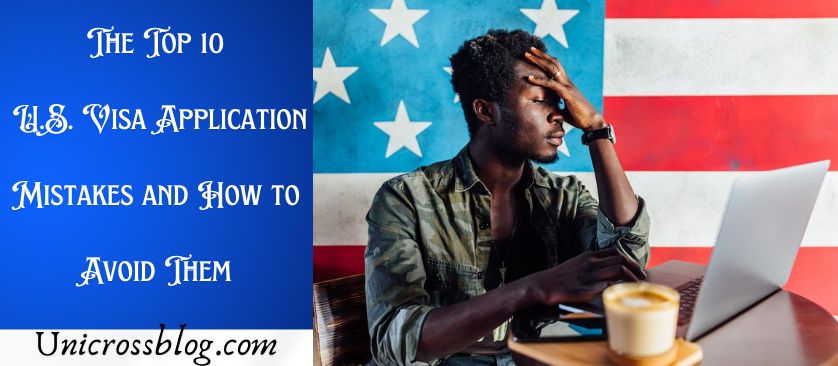Embarking on your journey to the United States begins with a crucial step: the visa application process. As you navigate this complex procedure, it’s essential to be aware of common pitfalls that can derail your plans.
Each year, countless applicants face delays or denials due to avoidable errors. By understanding the top 10 U.S. visa application mistakes, you can significantly improve your chances of success.
This article will guide you through these critical missteps and provide valuable insights on how to sidestep them. Armed with this knowledge, you’ll be better prepared to submit a flawless application and move confidently toward your American dream.

The Top 10 U.S. Visa Application Mistakes and How to Avoid Them
Applying for a U.S. visa can be a complex and daunting process. To increase your chances of success, it’s crucial to avoid common pitfalls that could lead to delays or denials. Here are the top 10 U.S. visa application mistakes and how to steer clear of them:
1. Submitting Incomplete or Inaccurate Information
One of the most frequent errors is providing incomplete or incorrect information on your application. This can raise red flags and lead to unnecessary delays or even rejection. To avoid this:
- Double-check all entries for accuracy before submission
- Ensure all required fields are filled out completely
- If you’re unsure about a question, consult the official U.S. Department of State website or seek professional assistance
2. Failing to Provide Sufficient Supporting Documentation
Inadequate documentation is another common stumbling block. To strengthen your application:
- Carefully review the specific requirements for your visa category
- Include all necessary documents, such as passports, photographs, and financial records
- Ensure all documents are current and properly translated if not in English
3. Misunderstanding Visa Categories
Applying for the wrong visa type can result in automatic denial. To prevent this:
- Research thoroughly to determine the most appropriate visa category for your purpose of travel
- Consult the U.S. Citizenship and Immigration Services (USCIS) website for detailed information on visa types
- Consider seeking advice from an immigration attorney if you’re unsure
4. Overlooking Interview Preparation
Many applicants underestimate the importance of the visa interview. To make a positive impression:
- Practice answering potential questions about your travel plans and intentions
- Prepare concise, honest responses to queries about your background and ties to your home country
- Dress professionally and arrive on time for your appointment
5. Ignoring Timing and Deadlines
Applying too late or too early can jeopardize your chances. To avoid timing issues:
- Begin the application process well in advance of your intended travel date
- Be aware of processing times for your specific visa category
- Pay attention to any deadlines for submitting additional information or attending interviews
6. Neglecting to Demonstrate Strong Ties to Home Country
Failure to show strong ties to your home country can lead to visa denial. To address this:
- Provide evidence of employment, property ownership, or family obligations in your home country
- Explain your plans to return home after your visit to the U.S.
- If you’re a student, include details about your academic plans in your home country
7. Submitting Poor Quality Photographs
Inadequate photos can delay your application. To ensure compliance:
- Follow the specific photo requirements outlined by the U.S. Department of State
- Use a professional photographer familiar with visa photo standards
- Avoid using old photos or those with inappropriate backgrounds or expressions
8. Disregarding Previous Immigration Violations
Failing to disclose past immigration issues can have serious consequences. To maintain transparency:
- Be honest about any previous visa denials or overstays
- Provide explanations and supporting documentation for any past immigration problems
- Consider consulting an immigration attorney if you have a complex immigration history
9. Underestimating Financial Requirements
Insufficient proof of financial stability can lead to visa denial. To demonstrate financial readiness:
- Provide recent bank statements, pay stubs, or other financial documents
- If you have a sponsor, ensure they provide the necessary financial documentation
- Be prepared to explain how you will cover your expenses during your stay in the U.S.
10. Failing to Seek Professional Assistance When Needed
While not everyone requires legal help, complex cases may benefit from professional guidance. Consider seeking assistance if:
- You have a complicated immigration history
- Your case involves unusual circumstances
- You’re unsure about how to interpret visa requirements or complete forms correctly
By avoiding these common mistakes and carefully following application instructions, you’ll significantly improve your chances of a successful U.S. visa application. Remember, attention to detail and thorough preparation are key to navigating the visa process smoothly.
READ ALSO: The Easiest U.S. Visa Options for Freelancers
FAQs
What documents do I need for a U.S. visa application?
The specific documents required for your U.S. visa application can vary depending on the visa type you’re applying for. However, some common documents include:
- A valid passport
- Nonimmigrant Visa Application (Form DS-160)
- Application fee payment receipt
- Passport-sized photograph
- Supporting documents specific to your visa category
It’s crucial to carefully review the requirements for your particular visa type on the official U.S. Department of State website. Gathering all necessary documents before submitting your application can help avoid delays or potential rejections.
How long does the U.S. visa application process take?
The processing time for U.S. visa applications can vary significantly based on several factors, including:
- The type of visa you’re applying for
- The volume of applications being processed
- The complexity of your case
- The completeness of your application
Generally, nonimmigrant visa applications are processed within a few weeks to a few months. However, some visas, particularly immigrant visas, can take several months or even longer. It’s advisable to apply well in advance of your intended travel date to account for potential delays.
Can I expedite my U.S. visa application?
In certain circumstances, you may be able to request expedited processing for your U.S. visa application. However, expedited processing is typically reserved for genuine emergencies or situations of urgent need. Some examples include:
- Medical emergencies
- Funeral attendance for an immediate family member
- Urgent business travel
To request expedited processing, you’ll need to provide documentation supporting your need for urgency. Keep in mind that expedited processing is granted at the discretion of the U.S. Embassy or Consulate and is not guaranteed.
What should I do if my U.S. visa application is denied?
If your U.S. visa application is denied, don’t lose hope. Here are some steps you can take:
- Understand the reason for denial: The consular officer should provide you with a reason for the denial. This information is crucial for addressing the issue in future applications.
- Review your application: Carefully go through your application to identify any errors or omissions that may have led to the denial.
- Gather additional supporting documents: If your application was denied due to insufficient evidence, consider gathering more comprehensive documentation to support your case.
- Consider reapplying: In many cases, you can reapply for a visa. However, it’s important to address the reasons for the initial denial before submitting a new application.
- Seek professional assistance: If you’re unsure about how to proceed, consider consulting with an immigration attorney or a reputable visa consultant who can guide you through the process.
Remember, each case is unique, and the appropriate course of action will depend on your specific circumstances and the reason for denial.
How can I check the status of my U.S. visa application?
You can check the status of your U.S. visa application online through the Consular Electronic Application Center (CEAC) website. To do this, you’ll need:
- Your application ID number
- The location where you submitted your application
Simply enter this information on the CEAC website to view your current application status. Keep in mind that processing times can vary, and the status may not be updated in real-time. If you have concerns about your application status, you can contact the U.S. Embassy or Consulate where you applied for more information.
By staying informed about these common questions and their answers, you can navigate the U.S. visa application process more confidently and avoid potential pitfalls.







